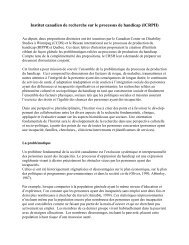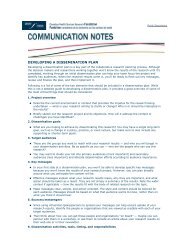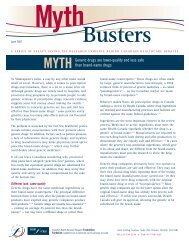Summary of Definitions of Continuity of Care
Summary of Definitions of Continuity of Care
Summary of Definitions of Continuity of Care
You also want an ePaper? Increase the reach of your titles
YUMPU automatically turns print PDFs into web optimized ePapers that Google loves.
Author(s) Year Definition <strong>of</strong> <strong>Continuity</strong>Hinman E.J.1978 3 elements for a continuity <strong>of</strong> care system: “first, there must be an organized system within which the care isprovided; second, there must be providers with the training and motivation to assure that the proper care is given(the principal provider <strong>of</strong> this care will be the primary physician); and third, there must be extensive patientinvolvement in the delivery process.”Cook, R.L.1979 “<strong>Continuity</strong> involves (1) patient participation in the planning, implementation, evaluation, and revision <strong>of</strong> hi/hernursing care based on reliable information; and (2) the continuous flow <strong>of</strong> relevant information about the patientbetween appropriate health-team members.”Hadac R.R., SmithC.K., Gordon M.J.1979 “<strong>Continuity</strong> <strong>of</strong> medical care can be defined as the extent to which medical care services are received as acoordinated and uninterrupted succession <strong>of</strong> events consistent with the medical care needs <strong>of</strong> patients.” (Shortell)Pereira Gray D.J.1979 Distinguishes between "personal" and "continuous" care. Personal refers to trusting and committed relationship.Continuous care refers to seeing same physician over time.Rosenthal J.M., Miller1979 “Effective inter-institutional communication.”D.B.Steinwachs D.M.1979 “Provider continuity” is “the extent to which individuals only one provider for their medical care.”Test M.A.Davis M.Z.Horan M.J., Steinwachs D.M.,Smith C.R., et al.Patten R.C., FribergR.1979 Dimensions <strong>of</strong> continuity: 1. “Cross-sectional care” – “at any given point in a chronically mentally ill person’streatment, the person must be involved in a system <strong>of</strong> care that is comprehensive (in meeting unmet needs) andintegrated.” 2. “Longitudinal continuity” – “care that is continuous and integrated over time.”1980 <strong>Continuity</strong> <strong>of</strong> care refers to “the integration over time <strong>of</strong> staff and patient information and actions directed towardfurthering the physical and social-psychological rehabilitation <strong>of</strong> the patient, beginning in the hospital andcontinuing after discharge.”1980 “The receipt <strong>of</strong> coordinated and uninterrupted health care services.”1980 Several definitions: 1. “Seeing the same physician over a period <strong>of</strong> time.” 2. “Receiving care in the same locationand having a single medical record.” 3. “The number <strong>of</strong> physicians seen in a single spell <strong>of</strong> illness.” 4. “The rate <strong>of</strong>complete immunization, the number <strong>of</strong> hospitalizations supervised by the regular provider.” 5. “The number <strong>of</strong>family members seeing the same physician.”Phillips W.R., Little T.L. 1980 “All visits with their own family physician.”Rogers J., Curtis P.1980 Model <strong>of</strong> <strong>Continuity</strong> includes: 1. Elements – Provider (“physicians and nurses, paramedical workers, socialworkers, etc.”) Consumer (“individuals, nuclear families and even larger cohorts <strong>of</strong> people (schools, industrialunits, etc.”) Medical interaction (direct – “May occur visually, verbally, or by the written word i.e., face-to-face,through the telephone or via medical records, messages, etc.”; indirect – “uses the same communication method but3














